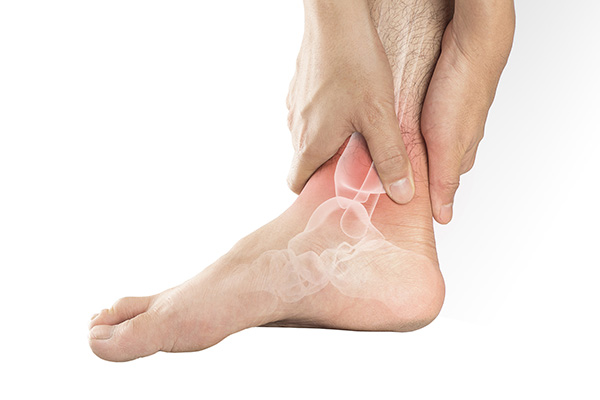We often hear the term hairline fracture, but do you know what the term means?
Orthopedic physicians describe hairline or stress fractures as tiny cracks that develop on bones in the foot or lower leg. A common injury in runners, gymnasts, and dancers, anyone can develop a hairline fracture through repetitive jumping or running. Individuals with osteoporosis also are at risk for hairline fractures.
The bones of the foot and leg absorb a lot of stress during running and jumping. Common sites for hairline fracture include the metatarsal bones – the five long and narrow bones connecting the mid-foot to the toes – as well as the heel, ankle bones, and the navicular, the bone on the top of the mid-foot.
What are the symptoms of a hairline fracture?
The most common symptom is pain that gradually worsens over time, especially if you don’t stop weight-bearing activity. Other symptoms include swelling, tenderness, and bruising.
What causes a hairline fracture?
An overuse or repetitive activity, or an increase in either the duration or frequency of activity, can result in a hairline fracture. Even regular runners who suddenly increase either their distance, such as someone training for a marathon, or the number of times per week they run, can cause a hairline fracture.
Another cause of a hairline fracture is changing the type of exercise normally performed.
Bones adapt to increased forces through various activities, where new bones form to replace old bone. This process is called remodeling. When the breakdown of bone happens more rapidly than new bone can form, the likelihood of developing a hairline fracture increases.
Who’s most at risk for developing a hairline fracture?
There are several risk factors that increase the chances of developing a hairline fracture:
- Certain sports: Participants in high-impact sports such as track and field, basketball, tennis, dance, ballet, long-distance runners, and gymnastics, increase their chances of getting a hairline fracture.
- Gender: Post-menopausal women have an increased risk of hairline fractures. Female athletes may be at a greater risk because of a condition called the “female athlete triad.” This is where extreme dieting and exercise may result in eating disorders, menstrual dysfunction, and premature osteoporosis.
- Foot problems: Poor footwear can cause injuries, so can high arches, rigid arches, or flat feet.
- Weakened bones: People with osteoporosis, or anyone taking medications that affect bone density and strength, can develop hairline fractures even when performing normal activities.
- Previous hairline fractures: Having one hairline fracture increases your chances of having another.
- Lack of nutrients:Lack of vitamin D or calcium can make bones more susceptible to fracture. People with eating disorders are at risk for this reason. There can be a greater risk of hairline fractures during the winter months when diminished sunlight decreases the body’s absorption of vitamin D, compounded by an increased risk of slips and trips on icy surfaces.
- Improper technique: Blisters, bunions, and tendonitis can affect how you run, altering which bones are impacted by certain activities.
- Changes in surface: Changes in playing surfaces can cause undue stress to the bones of the feet and legs. For example, tennis player who move from a grass court to a hard court may develop injuries.
How is a hairline fracture diagnosed?
If you believe you have a hairline fracture, it’s important to seek treatment from an orthopedic physician as soon as possible.
Your doctor will perform a physical exam and review your medical history and general health, including diet, medications, and other risk factors. Diagnostic tools may include an MRI, X-ray, or bone scan.
How are hairline fractures treated?
If you suspect you have a hairline fracture, follow the RICE method: rest, ice, compression and elevation. An over-the-counter, non-steroidal drug can help with pain and swelling.
It’s important to seek further treatment if the pain becomes severe or doesn’t get better with rest. The treatment your orthopedic physician recommends will depend on both the severity and location of your injury.
Can other conditions develop if hairline fractures aren’t treated?
Ignoring the pain caused by a hairline fracture can result in the bone breaking completely. Complete breaks will take longer to heal and involve more complicated treatments. It’s important to seek advice from an orthopedic physician and treat a hairline fracture as soon as possible.
Medical treatments
Your doctor may recommend that you use crutches to keep weight off an injured foot or leg. You can also wear protective footwear or a cast.
Because it usually takes up to six to eight weeks to completely heal from a hairline fracture, it’s important to modify your activities during that time. Cycling and swimming are great alternatives to more high-impact exercises.
In some cases, a hairline fracture may require surgery. The addition of pins or screws can help hold bones together during the healing process.
What’s the outlook for someone with a hairline fracture?
It’s important to avoid high-impact activities during the healing process. Returning to high-impact activities — especially the activity that caused the injury in the first place — will delay healing and increase the risk of a complete fracture in the bone.
Even after the hairline fracture is healed, it’s important to gradually return to exercise.
In rare instances, hairline fractures don’t heal properly. This result is chronic, long-term pain. Talk with a board-certified orthopedic physician soon after the injury occurs to prevent pain and worsening damage to the bone.

